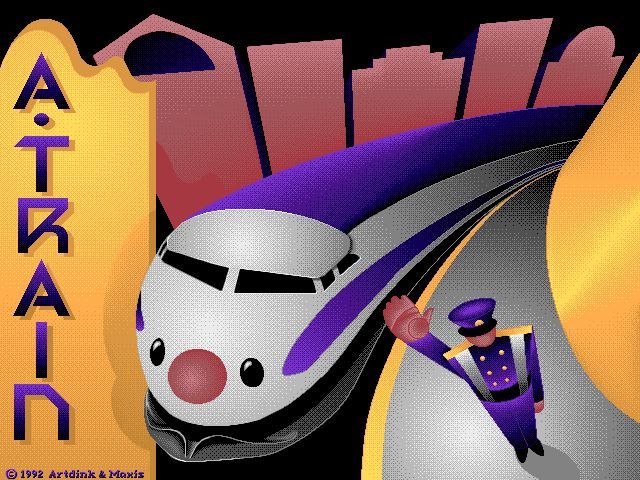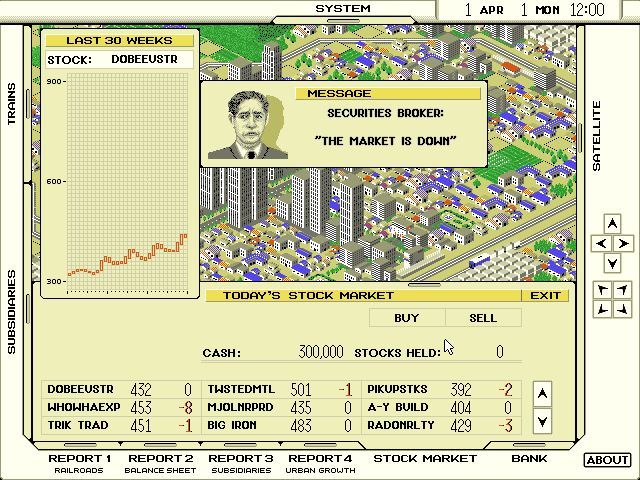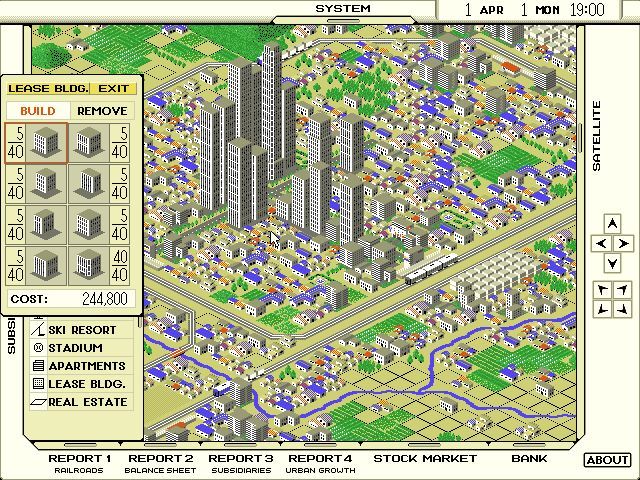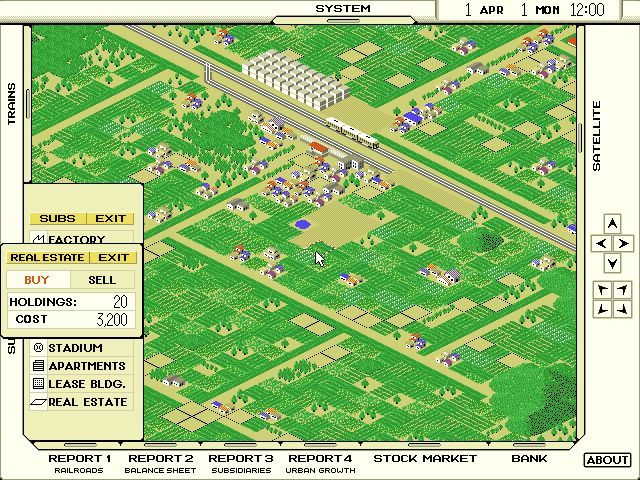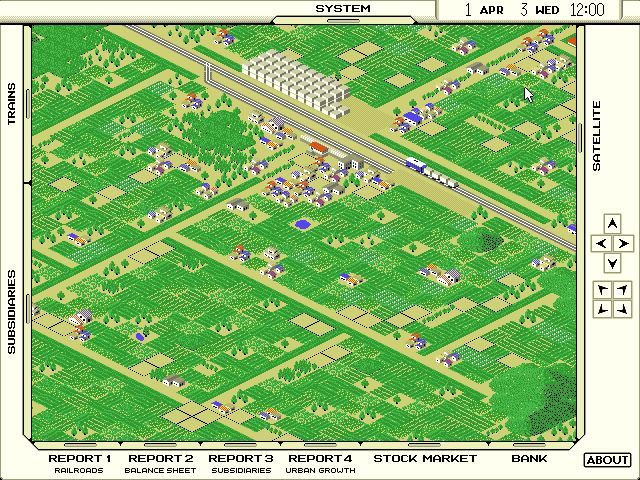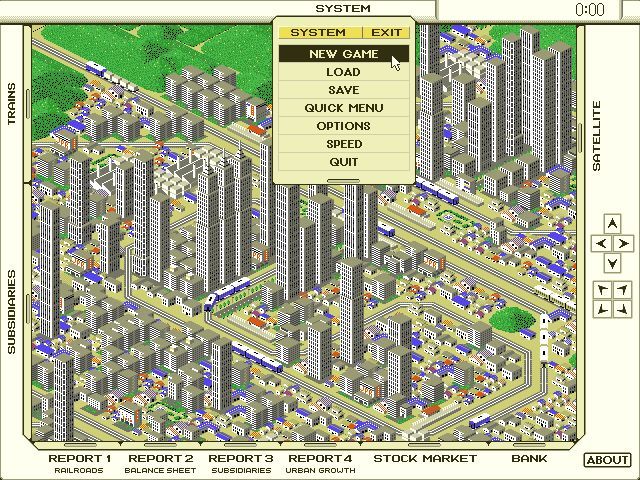A-Train (1992-)
A-Train was developed by Japanese studio Artdink and originally released in Japan in 1985. The version most widely known in the West was the third in the series, which was released for MS-DOS and later the Amiga and Macintosh in 1992, with Maxis acting as the publisher. The game stood out as part of Maxis’s broader effort to expand beyond SimCity, aligning with their focus on simulation titles. A-Train also saw a release on the Super Nintendo Entertainment System (SNES) under the title A-Train III in Japan, and simply A-Train in the West, with some variations in gameplay and presentation to suit the console audience.
The game’s premise revolves around running a private railway company with the goal of building a successful urban transport network. Players manage railway lines, control schedules, buy and sell land, and invest in city development. Over time, successful rail operations lead to urban growth around stations, requiring strategic planning and financial oversight. The interface was dense and complex, with a steep learning curve, but it offered a deeply rewarding simulation for those willing to engage with its systems. The slow pace and intricacies made it a niche but respected title among simulation enthusiasts.
A-Train was preceded by two Japan-only releases, but the Western version introduced many players to the series for the first time. The soundtrack, particularly in the SNES version, featured jazzy and ambient electronic compositions that reflected the slow-paced, strategic atmosphere of the game. The music provided a relaxed background that complemented the cerebral gameplay and city-building mechanics. Promotion in the West leaned heavily on Maxis’s reputation following the success of SimCity, with box art and marketing emphasising its place as part of a growing lineup of serious, simulation-based games.
Reception of A-Train was mixed upon its Western release. While some praised its depth and unique premise, many critics and players found the interface confusing and the gameplay too slow, especially when compared to more immediately engaging titles like SimCity. Still, it developed a small but devoted following who appreciated its ambition and the blend of transportation and urban development mechanics. Over time, it became something of a cult classic, helping Artdink secure a place in simulation history and paving the way for numerous sequels that refined and expanded the concept.
Key Features of A-Train:
Complex railway management including scheduling and expansion
Real estate investment and land development systems
Time-based simulation with evolving seasons and day-night cycles
Financial and stock market mechanics tied to urban growth
Unique ambient and jazz-style soundtrack (especially on SNES)
Multiple views and map zoom levels for detailed management
Images from MobyGames
Buy A-Train
Click one of the Ebay or Amazon buttons below to check the latest prices and purchase A-Train for that particular platform.



The evolution of the A-Train franchise

The A-Train series, known as A Ressha de Ikou in Japan, is one of the most enduring franchises in the simulation genre, with its origins dating back to the mid-1980s. The very first A-Train was released in 1985 on the NEC PC-8801, PC-9801, and MSX platforms. Developed by Artdink, this initial installment laid the foundation for the franchise’s unique blend of railway management and urban planning. It combined strategic route building and financial management, giving players a detailed and complex simulation experience that was quite advanced for its time.
Following the original’s success, A-Train II (1988) expanded on the core mechanics and was released on various platforms, including the PC-9801, MSX2, and later the Sega Genesis (known as the Mega Drive outside North America). This sequel refined the economic systems and introduced improved graphics and interface elements. Around the same period, A-Train was ported to the Nintendo Entertainment System (NES) in 1989, marking the franchise’s first appearance on a major home console. The NES version retained the core gameplay but was simplified due to hardware limitations.
The series continued evolving with A-Train III (1990), which brought deeper city-building elements and was available on platforms such as the PC-9801, Sharp X68000, and later Windows PCs. This entry introduced more detailed economic simulation and allowed players greater control over urban development in addition to managing railways. Around the same time, Artdink started experimenting with 3D graphics, a feature that would become significant in later entries.
In 1992, A-Train IV made its debut on the NEC PC-9801 and the Super Famicom (known as the Super Nintendo Entertainment System elsewhere). The Super Famicom version showcased a more polished visual presentation but still adhered closely to the franchise’s complex management gameplay. Meanwhile, the PC version introduced early 3D elements, enhancing the depth of city simulation and railway operations. The same year saw the release of A-Train Deluxe on the Sega Genesis, a streamlined version aimed at a wider audience but retaining core strategic elements.
A major leap came with A-Train 5 in 1996, which marked the series’ transition to 3D graphics on Windows PCs and later the PlayStation. This game provided a fully three-dimensional cityscape and train models, giving players an immersive experience in managing their railway empire. The 3D engine allowed for more dynamic camera controls and a more visually engaging presentation, while the gameplay became even more detailed with a wider variety of train types and economic factors to consider.
In 1999, A-Train 6 was released for Windows and PlayStation platforms, further refining the 3D simulation experience. It improved interface usability and added more intricate economic models, making it a favorite among hardcore fans. This installment also introduced more sophisticated train routing options and greater emphasis on financial strategy. The PlayStation version brought the franchise to a broader audience, although it remained a niche title due to its complexity.
The early 2000s saw the arrival of A-Train 7 (2000), which was launched on Windows PCs. This version expanded on city-building elements, allowing players to manage not only railways but also urban infrastructure, zoning, and land development in greater detail. The graphics saw incremental improvements, and the game’s simulation depth remained its defining feature. However, the user interface and steep learning curve kept the series somewhat inaccessible to casual gamers.
In 2006, A-Train 8 was released on Windows and later on PlayStation 3, marking the franchise’s first appearance on a high-definition console. This installment featured significantly enhanced graphics with detailed 3D models and textures, and it introduced a more modernized interface designed to appeal to a wider audience. Despite these improvements, A-Train 8 maintained the series’ core gameplay philosophy of complex economic and transportation simulation, solidifying its place as a serious title for simulation enthusiasts.
More recently, the franchise has adapted to modern platforms with A-Train Express (2011) for the Nintendo 3DS, bringing the classic gameplay to handheld devices with updated graphics and streamlined controls. Additionally, mobile adaptations have allowed new generations to experience A-Train on smartphones and tablets, making the franchise more accessible than ever before. Throughout its long history, A-Train has remained true to its roots—delivering a detailed, slow-paced, and rewarding simulation that celebrates the intricacies of railway management and urban development across a wide range of platforms and technological eras.
Related Searches
A-Train is available to purchase and download from a range of vendors. Always shop around...
A-Train may be available to download as abandonware from one of the many sites that offer this. Search now....
There are various sites out there that can offer cheat codes for games. Search now to find all available...
There are many sites out there that have collated and documented historic reviews of this game. Search now...
We don't host or link to rom sites for this game. However, there are many sites out there that may be...
The initial release date for A-Train is stated as December 1990. Other ports of the game may have been....
A-Train is available to purchase and download from the link(s) shown further up this page....
There are multiple sites around the internet that offer visual guides to this game. Search now to find the....


